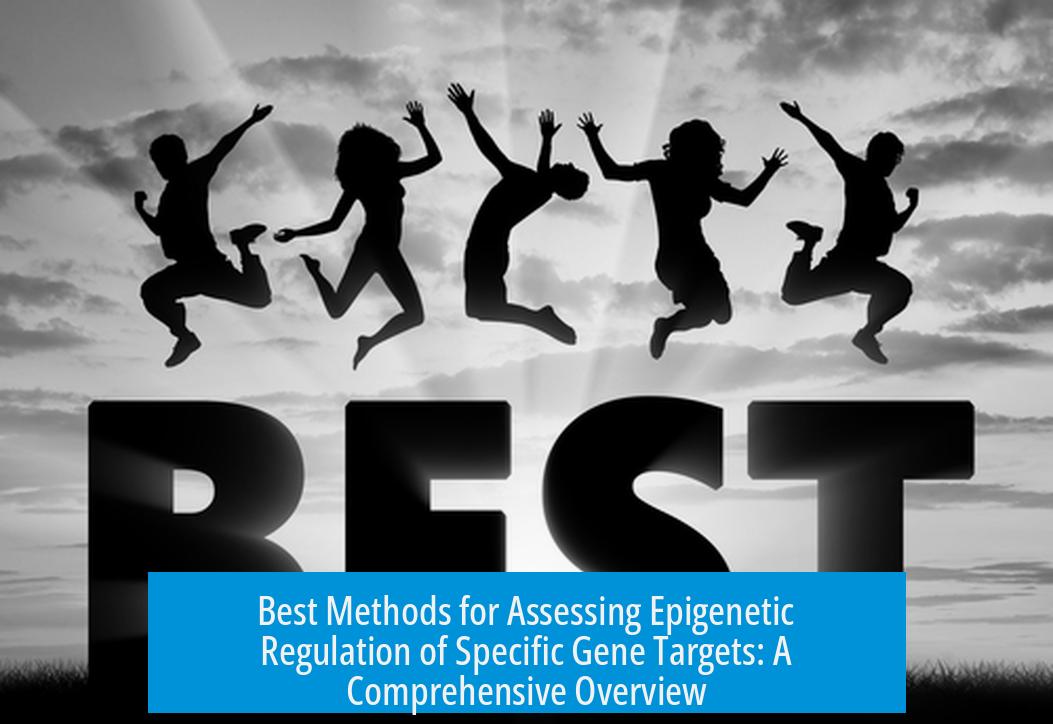Best Methods for Assessing Epigenetic Regulation of Specific Gene Targets
Assessing epigenetic regulation of a specific gene target involves evaluating DNA methylation, chromatin modifications, and miRNA-mediated control. Key methods include bisulfite sequencing for DNA methylation, chromatin immunoprecipitation (ChIP) combined with qPCR or sequencing for chromatin marks, and PCR-based assays with bioinformatics support for miRNA regulation.
1. DNA Methylation Assessment

Bisulfite Conversion PCR and Bisulfite Sequencing
DNA methylation is a primary epigenetic mechanism where methyl groups attach to cytosines, primarily at CpG dinucleotides. Assessing methylation patterns at specific gene loci relies heavily on bisulfite conversion techniques.
- Bisulfite treatment converts unmethylated cytosines into uracils, while methylated cytosines remain intact.
- This chemical change allows for subsequent PCR amplification and sequencing to distinguish methylated from unmethylated positions.
- Bisulfite sequencing, both targeted and genome-wide, provides base-resolution methylation maps for a gene of interest.
- Bisulfite PCR enables targeted analysis of CpG-rich regions in the gene promoter or regulatory regions.
Though bisulfite methods are standard, newer approaches with improved sensitivity and yield have emerged, but bisulfite sequencing remains widely used due to its specificity and base-resolution detail.
Considerations

- DNA quality is crucial since bisulfite treatment degrades DNA.
- Careful primer design ensures specific amplification of converted DNA.
- Validation of conversion efficiency through controls is important.
2. Chromatin Modifications Assessment
Chromatin structure and histone modifications define accessibility and transcriptional activity of genes. Mapping chromatin modifications on specific loci is vital for understanding regulation.
Chromatin Immunoprecipitation (ChIP) + qPCR or ChIP-seq
ChIP uses antibodies specific to histone modifications or chromatin-associated proteins to isolate DNA fragments bound by these proteins.
- ChIP-qPCR: Quantifies enrichment at a specific gene locus; ideal for focused studies on known candidates.
- ChIP-seq: Combines ChIP with next-generation sequencing for genome-wide mapping of chromatin marks.
This approach identifies histone modifications such as H3K4me3 (active promoters), H3K27me3 (repressed regions), or acetylation marks that influence gene expression.
Chromatin Pulldown Followed by Mass Spectrometry
Recent advances allow selective capture of chromatin fragments containing the DNA sequence of interest, followed by proteomic analysis.
- DNA is used as bait to pulldown chromatin complexes bound to the target gene sequence.
- Mass spectrometry then identifies histone modifications and other proteins present in the complex.
- This method provides a detailed view of chromatin composition and modification states without relying solely on antibodies.
This approach complements ChIP by giving insight into the total protein milieu at the gene locus.
3. miRNA-Mediated Regulation
MicroRNAs (miRNAs) do not alter DNA or chromatin marks but regulate gene expression post-transcriptionally. Assessing miRNA impact on a gene involves different strategies.
Expression and Abundance Measurement
- qRT-PCR, especially TaqMan assays, quantify miRNA expression levels with specificity.
- Northern blot and in situ hybridization localize miRNA expression spatially and verify size.
- Small RNA sequencing profiles the abundance of all miRNAs in the system.
- Determining if the candidate miRNA is sufficiently expressed is key since low expression limits regulatory potential.
Target Prediction and Experimental Validation
- In silico tools like TargetScan identify conserved binding sites on the 3′ untranslated region (3’UTR) of the mRNA target.
- Reporter assays are constructed by fusing the 3’UTR of the gene target to a fluorescent protein (e.g., GFP or mCherry).
- Transfecting cells with miRNA mimics or inhibitors alongside the reporter reveals regulatory effects by measuring fluorescence changes.
Perturbation Experiments
- miRNA function is tested by overexpression or knockdown in relevant cell systems.
- Effects on the target gene’s mRNA and protein levels are measured to confirm regulatory relationships.
- These experiments assess causality rather than correlation.
Summary Table of Methods
| Regulation Type | Methods | Purpose and Notes |
|---|---|---|
| DNA Methylation | Bisulfite Conversion PCR, Bisulfite Sequencing | Base-resolution detection of methylated cytosines; sensitive to DNA quality; new methods improve yield. |
| Chromatin Modifications | ChIP-qPCR, ChIP-seq, Chromatin Pulldown + Mass Spectrometry | Maps histone modifications on gene loci; ChIP-seq gives genome-wide data; pulldown+mass spec identifies complex composition. |
| miRNA Regulation | qRT-PCR (TaqMan), Northern Blot, in situ, Small RNA-Seq, TargetScan, Reporter Assays, Perturbation | Quantifies miRNA levels, predicts targets, tests regulation by reporter constructs and functional assays. |
Choosing the Right Method
Selection depends on the research question and resource availability. For mapping epigenetic marks directly involved in transcriptional control, combine bisulfite sequencing and ChIP methods.
For post-transcriptional regulation by miRNAs, prioritize expression profiling, computational prediction, and functional assays.
Combining approaches gives a comprehensive view of epigenetic regulation on a specific gene.
Additional Methodological Notes
- Controls: Include positive and negative controls to validate assay specificity and efficiency.
- Sample preparation: High-quality nucleic acids and chromatin are essential for reproducible results.
- Replicates: Technical and biological replicates improve confidence in data interpretation.
- Data validation: Complement primary assays with orthogonal methods where possible to confirm findings.
Emerging Techniques
New technologies such as nanopore sequencing can directly read base modifications without bisulfite treatment. CUT&RUN and CUT&Tag enable targeted chromatin profiling with low input samples.
Single-cell epigenomics offers insights into cell-specific regulation but remains technically demanding.
Mass spectrometry-based proteomics of chromatin complexes continues to grow, revealing novel histone modifications and interacting proteins.
Summary of Key Points
- Bisulfite sequencing remains the gold standard for DNA methylation at specific genes.
- ChIP combined with qPCR or sequencing maps chromatin modifications with precision.
- Chromatin pulldown plus mass spectrometry characterizes histone modifications without reliance on antibodies.
- miRNA regulation involves expression profiling, target prediction, reporter assays, and perturbation experiments.
- Complementary use of these methods provides a comprehensive picture of epigenetic regulation of gene targets.
How does bisulfite sequencing help assess DNA methylation on a specific gene?
Bisulfite treatment converts unmethylated cytosines to uracil, leaving methylated cytosines untouched. This change allows mapping of methylation patterns by sequencing the treated DNA.
What is the difference between ChIP-qPCR and ChIP-seq for studying chromatin modifications?
ChIP-qPCR targets specific gene regions to quantify chromatin marks. ChIP-seq provides a broader genome-wide map of histone modifications and protein-DNA interactions.
How can chromatin pulldown combined with mass spectrometry reveal histone modifications?
Chromatin pulldown isolates DNA-protein complexes for a specific sequence. Mass spectrometry then identifies the types of histone modifications present on those chromatin fragments.
What methods are recommended to assess miRNA regulation on a target gene?
Use qRT-PCR or Northern blot to measure miRNA expression. Predict miRNA binding sites with bioinformatics tools like TargetScan. Validate effects with reporter assays and perturbation experiments.
Why are perturbation experiments essential when studying miRNA-gene regulation?
They test the functional impact of miRNAs by altering their levels. This confirms if changes in miRNA abundance affect the expression of the gene of interest.





Leave a Comment